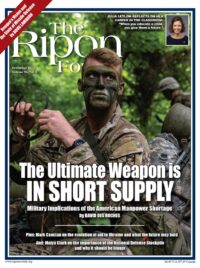
Vladimir Putin’s invasion of Ukraine and accompanying nuclear threats demonstrate the continued importance of nuclear deterrence to American security. Today, the United States maintains a nuclear deterrent second to none. The threat of America’s nuclear arsenal gives adversaries reason to avoid conflict with the United States and its allies.
The recent publication of the president’s Nuclear Posture Review (NPR) lays out a vision for how to reinforce nuclear deterrence in the coming decades. While this review is a useful framework, the real challenges are yet to come. The president and Congress must work together to ensure that nuclear modernization receives the funding that it needs. At the same time, the president should lay out a clearer pathway towards future arms control with China and Russia.
Nuclear deterrence has moved back to the center of national security discussions as a result of Putin’s irresponsible threats. Putin’s truly scary behavior reinforces the critical importance of deterring nuclear use by lawless regimes. Fortunately, Putin’s threats come from a place of weakness. Russia is losing the war on the ground to Ukrainian forces backed by Western aid. Putin’s nuclear threats are designed to drive a wedge into the coalition supporting Ukraine. Thus far, they have not succeeded.
In fact, Russia’s lack of nuclear use, despite embarrassing losses on the battlefield, shows that on some level deterrence is still working. Many analysts have worried that although the United States and Russia have similar numbers of large “strategic” nuclear weapons, the Russians have several thousand shorter-range “tactical” nuclear weapons, while the United States has only a few hundred. Yet the Russians have struggled to translate this numerical edge into actual battlefield advantage.
Nuclear deterrence has moved back to the center of national security discussions as a result of Putin’s irresponsible threats.
If Russia used its large tactical nuclear force indiscriminately, it would risk escalation to total nuclear war with the United States, a war that Russia knows it cannot win. Even using a few tactical nuclear weapons could have significant consequences for the Putin regime. Aside from furthering Russia’s diplomatic and economic isolation, Russian nuclear use might provoke direct NATO attacks on Russia’s weakened military. As a result, Putin has neither used nuclear weapons against Ukraine nor widened the conflict to attack NATO countries supplying Ukraine’s military. NATO’s ability to dominate Russia in a conventional conflict, combined with the United States’ large strategic nuclear arsenal, make nuclear escalation a losing game for the Putin regime. In the short term, the best thing the United States can do in response to Putin’s nuclear threats is continue its support of Ukrainian success on the battlefield.
Over the longer term, however, the United States will need to take additional steps to reinforce nuclear deterrence. While Russia has been deterred from nuclear escalation thus far, Putin’s decision to invade Ukraine in the first place represents a catastrophic failure that has had dire consequences, especially in the increase of energy and food insecurity. In the future, we should hope to deter such aggression in the first place, rather than simply deterring the worst sorts of behavior within an otherwise-devastating war. Perhaps even more troubling, China has embarked on a new program of nuclear expansion to create, for the first time, a nuclear arsenal close in size to that of the United States and Russia. While the threat from China and Russia have matured, much of the American nuclear arsenal has aged far beyond its useful lifespan. The U.S. nuclear arsenal is currently supported by last century’s equipment: 40-year-old submarines, 50 year-old missiles, and 70-year-old bombers.
The president’s declassified NPR lays out a vision for how to meet these challenges. Critically, the review retains the current nuclear declaratory posture, in which the United States promises to employ nuclear weapons to defend the “vital interests” of the United States and its partners in “extreme circumstances.” These deliberately open-ended criteria both deter adversaries and reassure allies of the United States’ commitment to their defense. The review also commits to modernizing the entirety of the strategic nuclear arsenal, including long-range missiles, submarines, and bombers. Finally, the review emphasizes the importance of modernizing our national nuclear infrastructure, which is critical in a long-term nuclear competition with our adversaries.
The U.S. nuclear arsenal is currently supported by last century’s equipment: 40-year-old submarines, 50 year-old missiles, and 70-year-old bombers.
While the new NPR points in the right direction, the real challenges are yet to come. Carrying forward the president’s vision will require that Congress consistently provides the resources necessary to carry it out. Russia’s invasion of Ukraine has temporarily made it easier to win support for such funding, but nuclear modernization is not something that we can accomplish in a year or two. We need to build consistent, bipartisan support for long-term funding of new nuclear weapons systems and the infrastructure to maintain and upgrade them. Funding for this long-term project has increased in recent years, but significant spending remains ahead, to the tune of hundreds of billions of dollars over the next few decades. While a significant sum, the cost of modernization represents only a small fraction of the annual defense budget. When set against the risks of major wars with China and Russia, the cost of the deterrent is small compared to its security benefits.
Force modernization should be combined with a renewed commitment to arms control to reduce the nuclear dangers that our adversaries pose to the United States. Indeed, the new NPR rightly notes that arms control can play an important role in limiting the nuclear threats from China and Russia. Unfortunately, it does not provide a clear roadmap for how to bring this about. We need to resist advice from well-intentioned disarmament advocates that the best way to reduce nuclear danger is for the United States to “lead the way” in unilaterally dismantling its nuclear forces. History suggests that “leading the way” by example is rarely an effective approach to bringing recalcitrant adversaries into arms control negotiations.
Rather, adversaries are likely to pocket any unilateral concessions while continuing their malign behavior. Instead, future success in deterrence and arms control will depend on the bargaining leverage generated by American nuclear modernization and other force development, including continued work on long-range conventional missiles and missile defense systems. Ensuring that we fund and build those systems is thus the best program for ensuring both future deterrence and arms control.
John D. Maurer is a professor at the School of Advanced Air and Space Studies at Air University and a nonresident fellow at the American Enterprise Institute. His book, Competitive Arms Control, was recently published by Yale University Press. The views expressed are those of the author and do not reflect the official policy or position of the Air Force, Department of Defense, or the U.S. government.




